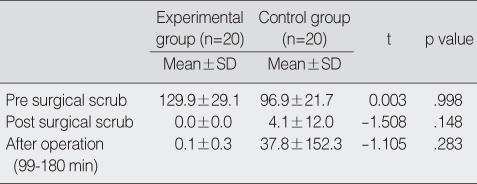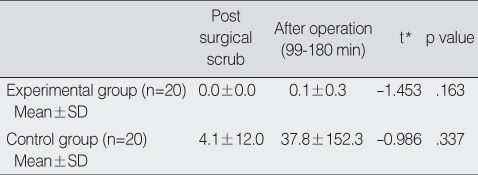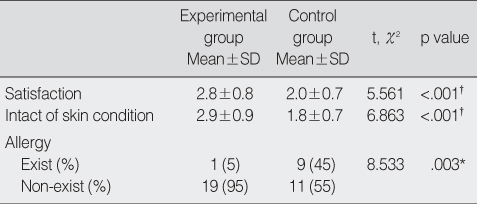Articles
- Page Path
- HOME > J Korean Acad Nurs > Volume 38(1); 2008 > Article
-
Original Article
- Evaluation of a Waterless, Scrubless Chlorhexidine Gluconate/Ethanol Surgical Scrub and Povidone-Iodine for Antimicrobial Efficacy
- Jeong Sil Choi
-
Journal of Korean Academy of Nursing 2008;38(1):39-44.
DOI: https://doi.org/10.4040/jkan.2008.38.1.39
Published online: February 28, 2008
Full-time Lecturer, Department of Nursing Science, Konyang University, Daejeon, Korea.
- Address reprint requests to: Choi, Jeong-Sil. Department of Nursing Science, College of Medical Science, Konyang University, 685 Gasuwon-dong, Seo-gu, Daejeon 320-718, Korea. Tel: 82-42-600-6346, Fax: 82-42-600-6307, jschoi408@empal.com
• Received: May 29, 2007 • Accepted: October 24, 2007
Copyright © 2008 Korean Society of Nursing Science
Abstract
-
Purpose
- The purpose of this study was to compare 1% chlorhexidine-gluconate/61% ethanol (CHG/Ethanol) emollient and 7.5% povidone-iodine (PVI) scrub for antimicrobial,residual effect, and skin condition.
-
Methods
- CHG/Ethanol emollient hand hygiene was performed waterless, and brushless by operating doctors and nurses (N=20). PVI hand washing was performed with water and a brush (N=20) for 5 min. The subjects were asked to press their left hand in hand-shaped agar before a surgical scrub, immediately after a surgical scrub and after the operation. The amount of isolated microorganisms were calculated by counting the number of divided areas(1×1 cm, 160 cell) which were culture positive in the hand culture plate. The skin condition was evaluated.
-
Results
- The antimicrobial count of CHG/Ethanol emollient and PVI immediately post surgical scrub was 0.0 vs. 4.1 (p>.05), and after the operation was 0.1 vs. 37.8 (p>.05)respectively. The Residual effect of CHG/Ethanol emollient immediately post surgical scrub and after the operation were 0.0 vs. 0.1 (p>.05), and PVI were 4.1 vs. 37.8 (p>.05)respectively. The skin condition and satisfaction of CHG/Ethanol emollient was higher than PVI (p<.05).
-
Conclusion
- The antimicrobial effect between CHG/Ethanol emollient and PVI were the same. Considering skin condition, satisfaction and allergic reaction CHG/Ethanol emollient for surgical scrub is recommended in Korea.
- 1. Bischoff WE, Reynolds TM, Sessler CN, Edmond MB, Wenzel RP. Handwashing compliance by health care workers: the impact of introducing an accessible, alcohol-based hand antisepsis. Arc Intern Med. 2000;160:1017–1021.
- 2. Bulus N, Kaleli I. Comparison of antibacterial effects of different antiseptics after hand washing. Mikrobiyol Bul. 2004;38(1-2):137–143.PubMed
- 3. CDC. Guideline for hand hygiene in health-care settings. MMWR. 2002;51(RR-16.Article
- 4. Earl ML, Jackson MM, Rickman LS. Improved rates of compliance with hand antisepsis guidelines: a three-phase observational study. Am J Nurs. 2001;101:26–33.
- 5. Grove GL, Zerweck CR, Heilman JM, Pyrek JD. Methods for evaluating changes in skin condition due to the effect of antimicrobial hand cleansers: two studies comparing a new waterless chlorhexidine gluconate/ethanol-emollient antiseptic preparation with a conventional water-applied product. Am J Infect Control. 2001;29:361–369.PubMed
- 6. Jeong JS. Effect of Handwashing Improving Programs on the Adherence of Hand Washing and Nosocomial Infections in a Surgical Intensive Care Unit. 2002;Seoul, Seoul National University. Unpublished doctoral dissertation.
- 7. Jeong JS, Kim DH, Kim MN, Choe MA. Bactericidal effect of waterless alcohol gel hand washing agent. J Korean Biol Nurs Sci. 2002;4:127–137.
- 8. Kjolen H, Anderson BM. Handwashing and disinfection of heavily contaminated hands- effective or ineffective. J Hospi Infect. 1992;21:61–71.Article
- 9. Larson EL. Skin hygiene and infection prevention: More of the same or different approaches? Clin Infect Dis. 1999;29:1287–1294.ArticlePubMed
- 10. Larson EL. Comparison of different regimens for surgical hand preparation. ARON J. 2001;73:412–432.ArticlePDF
- 11. Mulberrry G, Snyder AT, Heilman J, Pyrek J, Stahl J. Evaluation of a waterless, scrubless chlorhexidine gluconate/ethanol surgical scrub for antimicrobial efficacy. Am J Infect Control. 2001;29:377–382.ArticlePubMed
- 12. Park ES, Kim KS, Lee WJ, Jang SY, Choi JY, Kim JM. The Economical Impact of Surgical Site Infection. Korean J Nosocomial Infect Control. 2005;10(2):57–64.
- 13. Park ES, Jang SY, Kim KA, Kim YS, Jung SK, Woo KJ, et al. Comparison of waterless, brushless chlorhexidine/ ethanol emollient with povidone-iodine surgical scrubs. Korean J Nosocomial Infect Control. 2006;11(1):50–57.
- 14. Revised nomenclature for allergy for global use: Report of the Nomenclature Review Committee of the World Allergy Organization, October 2003. J Allergy Clin Immunol. 2004;113:832–836.ArticlePubMed
- 15. Smith DR, Ohmura K, Yamagata Z. Prevalence and correlates of hand dermatitis among nurses in a Japanese teaching hospital. J Epidemiol. 2003;13:157–161.ArticlePubMed
- 16. Smith DR, Smyth W, Leggat PA, Wang RS. Prevalence of hand dermatitis among hospital nurses working in a tropical environment. Aust J Adv Nurs. 2005;22:28–32.PubMed
- 17. Visscher M, Canning J, Said D, Wickett R, Bondurant P. Effect of hand hygiene regimens on skin condition in health care workers. Am J Infect Control. 2006;34:111–123.
- 18. 3M Avagard. Chlorhexidine Gluconate 1% solution and Ethyl alcohol 61% guideline. 2002;Unpublished manuscript.
REFERENCES
Figure & Data
REFERENCES
Citations
Citations to this article as recorded by 

- Two-Layer Wound Sealing before Surgical Hand Washing for Surgeons with a Minor Cut Injury on the Hand
Chan Yoon, Hyun Sik Gong, Jung Soo Park, Hyun Sik Seok, Jin Woo Park, Goo Hyun Baek
Surgical Infections.2019; 20(5): 390. CrossRef - The Efficacy of Chlorhexidine in Hemodialysis Vascular Access Device Disinfection
Ji-Hyun Yang, Young-Mi Yu, Min-Gyeong Yu, Sung-Mi Moon, Sue-Jean Park
Quality Improvement in Health Care.2017; 23(1): 55. CrossRef
Evaluation of a Waterless, Scrubless Chlorhexidine Gluconate/Ethanol Surgical Scrub and Povidone-Iodine for Antimicrobial Efficacy

Figure 1
Process of hand culture.
Figure 1
Evaluation of a Waterless, Scrubless Chlorhexidine Gluconate/Ethanol Surgical Scrub and Povidone-Iodine for Antimicrobial Efficacy
Comparison of Bacterial Count between Experimental and Control Group of Antibacterial Efficiency (CFU/160 cm²)
Comparison of Bacterial Count between Experimental and Control Group of Residual Effect (CFU/160 cm²)
*paired t-test.
Comparison of Satisfaction, Skin Condition and Allergy between Experimental and Control Group
*p<.01; †p<.001.
Table 1
Comparison of Bacterial Count between Experimental and Control Group of Antibacterial Efficiency (CFU/160 cm²)
Table 2
Comparison of Bacterial Count between Experimental and Control Group of Residual Effect (CFU/160 cm²)
*paired t-test.
Table 3
Comparison of Satisfaction, Skin Condition and Allergy between Experimental and Control Group
*p<.01; †p<.001.
 KSNS
KSNS
 E-SUBMISSION
E-SUBMISSION




 Cite
Cite

